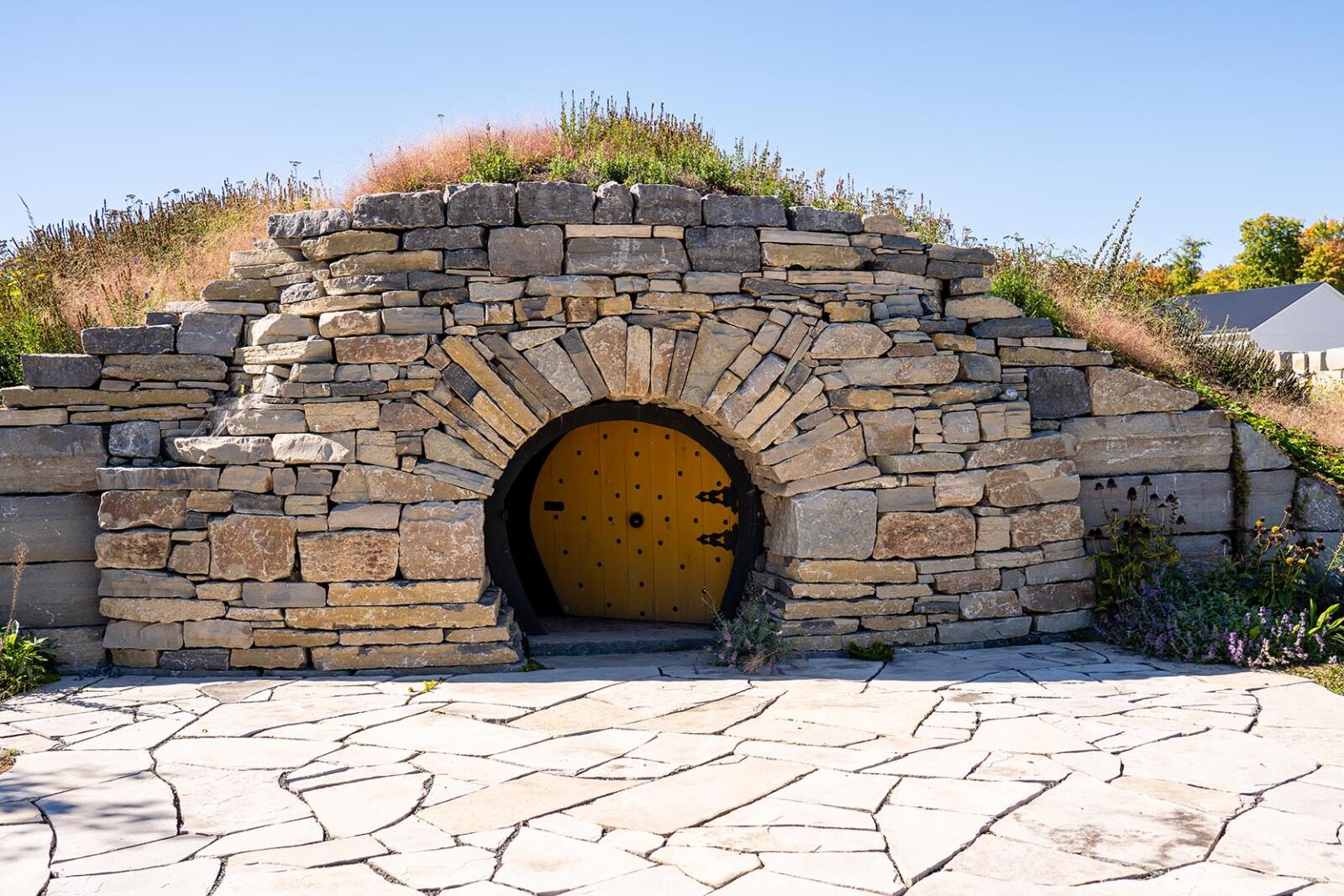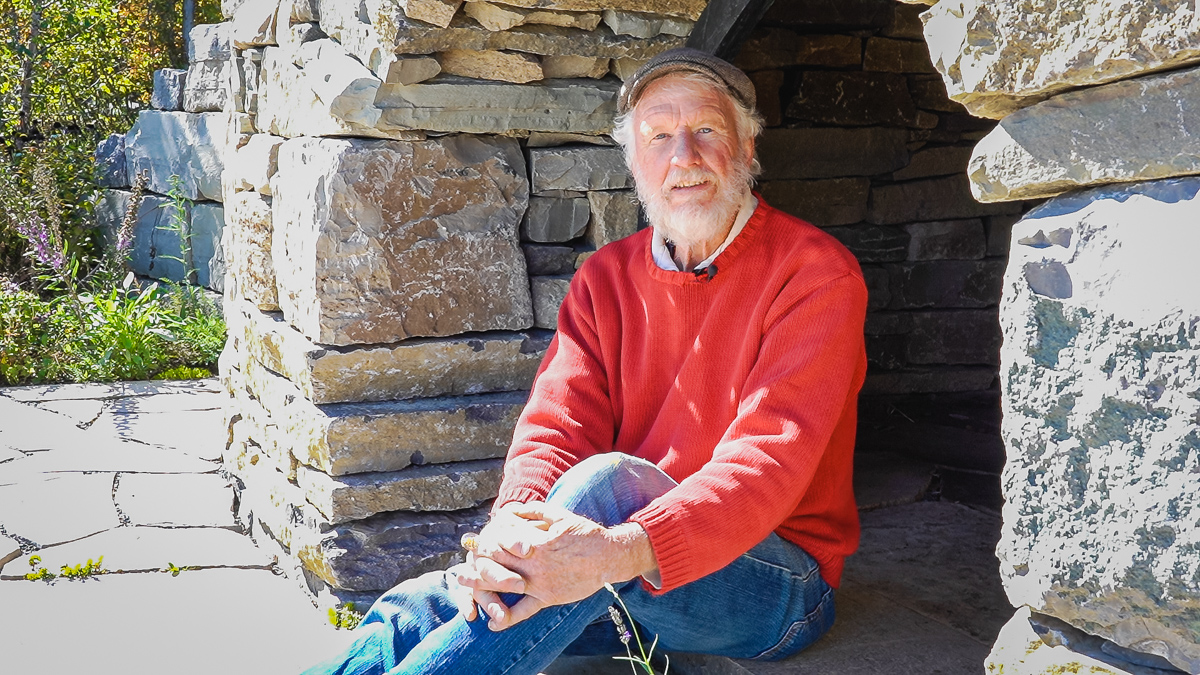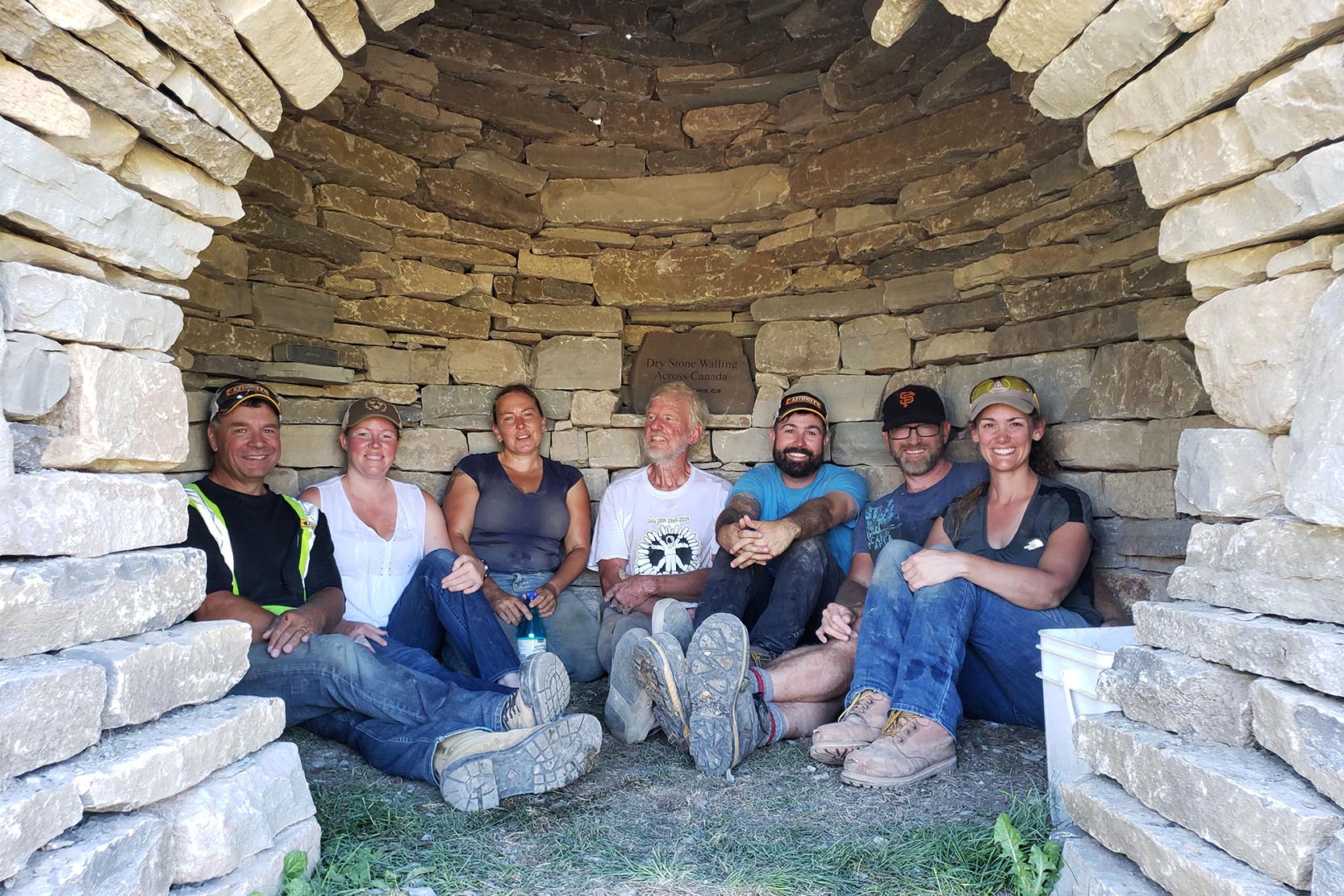
The magic and mystery of dry stone
The enchanting hobbit house at Dibbits Landscape Supply takes you back in time
BY KARINA SINCLAIR
On a quest for armour stone and river rock, the intrepid landscaper needs only to journey to Dibbits Landscape Supply in Trenton, Ont. There, a vast array presents itself, but first, the adventurer must make it past the ancient mystical monument known only to those with secret knowledge: the hobbit house.
Well, okay, it’s not exactly a secret, and it’s not ancient, either. But it does have an aura of mystery. And if you’re lucky enough to wander toward Prince Edward County, you’ll encounter an utterly charming dry stone home with a round, cheery yellow front door nestled between a pond and a waterfall.
A destination in place and time
Even though the structure has only been in place since 2019, the dry stone dome evokes a sense of time travel. Looking closely, you may find fossils from another epoch. After all, the limestone bedrock of Southern Ontario was once under a tropical sea some 500 million years ago (give or take a few million).
This monument marks the entrance to a decidedly modern enterprise. Skid steers and forklifts kick up clouds of dust as they shuffle loads of mulch, gravel, and stone pavers into clients’ trailers. Once upon a time, the long-running family business solely focused on excavation services but has since pivoted to landscape supply.
You might wonder why a landscape supply yard would host such an unusual structure; you wouldn’t be the first to ponder.
“Many people that are mentors to me would often ask, ‘why would you spend so much resources on building a display item that doesn’t show a return on your investment?’” said Joe Dibbits, owner and president of Dibbits Landscape Supply. “But the big part of what we do here at Dibbits is we want to not necessarily just inspire people, but we want to make Dibbits a destination. And we’d like to see people come to see the hobbit house. They don’t necessarily have to come to buy products.”
 Joe Dibbits — Photo by Karina Sinclair
Joe Dibbits — Photo by Karina Sinclair
Even in the early stages of planning a destination-worthy feature, Dibbits knew he wanted some kind of dry stone structure. He invited renowned stone artist John Shaw-Rimmington to take a look at the site. Together, they considered different possibilities, but when Shaw-Rimmington asked him what he really wanted, Dibbits drew on inspiration from literature.
“I’ve always enjoyed the Hobbit series by Tolkien, and I just mentioned it would be kind of cool to have built our own hobbit house.” Dibbits recalled Shaw-Rimmington enthusiastically replied: “I’ve never built a house. Let’s do it.”
And so the saga began.
Community building
“We thought it would be nice to give an opportunity for others to be involved,” Dibbits said. “There’s a lot of people in the landscape industry and even those outside it have an interest in stone. So we put it out there to invite people and it was open to anyone.”
The experience took the project from foundation to copestone completion. Shaw-Rimmington said: “We built it without any machinery. It was all done as a workshop with, I think, four men and four women over two weekends. And we were happy, happy, happy people.”

Dry stone wall builder John Shaw-Rimmington at the Hobbit House. Photo by Karina Sinclair
After tucking himself quite nimbly into the curved entrance of the house, self-proclaimed “creative stone guy” Shaw-Rimmington explained this particular structure was made in reference to a movement that has encompassed magic, enchantment, and many of the things that stone inspires in people. “I think this structure is really something that is almost wanting to be built out of stone. It’s appealing to your imagination. It’s appealing to a sense of history,” Shaw-Rimmington said.
And now, though created in a relatively quick timeframe, the stone house looks as though it’s been in place since time immemorial. “That is one of the main qualities of stone,” Shaw-Rimmington said, “if you’re careful and you do it right, it will look like it’s been there forever.”
Talk to the hand
As modern trends lean toward precision cuts and high polish, the rawness of this structure is what makes it so intriguing. “I like to use stone to draw people out of their normal day-to-day world. I think stone is that raw ingredient that, if used properly, captures an element of other,” Shaw-Rimmington mused.
The former conservation stonemason explained there’s an unspoken rule that if you don’t have to shape it, don’t. “That’s really one of the key things — it’s accepting that nature provides for you. Look at your stones you have and accept them for what they are rather than want to change them first,” he said. “I encourage people who are working with me to refrain from bringing out the saws and the hammers and things. We are hung up as a culture on perfection. I’ve discovered that there’s a lot of things you can do that are within that range of ‘Yeah, that’s okay.’”
The building crew inside the Hobbit House.
When asked how he knows where to place each stone, Shaw-Rimmington chuckled at what he called a loaded question. “There’s two different types of knowledge,” he said. “There’s our technical cerebral knowledge and there’s our body knowledge. And stone loves to work with both. I’ve discovered that sometimes my hands will pick up a stone and my brain will try to convince me by saying ‘that’ll never fit there’ and my hands say ‘we’ll just try it.’ Then you just come to the wall with a stone as a sort of gift and you say, ‘Is it here? Does it work?’ And more than often it does.”
He suggests that synchronicity comes when you allow yourself to be open. “The stone is trying to teach you something. There are places in life where there are these tiny synchronicities where you go, ‘Hmm, is there something else going on here?’ And I think if you enjoy that feeling and want to experience it more, stone is the best place to start because the synchronicities seem to happen more,” Shaw-Rimmington said. “It’s a very important, life-changing thing.”
Stronger together
That open-minded approach works for Dibbits, too, who sees his role in the landscape industry as helping others build, stone by stone, toward their own success stories. “It’s not that we just want their business. We want to be a part of what they do. We hope that we can maybe mentor them in some way, make their business better. And I think there’s unlimited potential in this industry,” said Dibbits. His goal is to “walk the journey with as many people as possible.”
His advice for his peers is to “Look at it as a shared journey. So whether that’s, you know, with other landscape supplier dealerships or contractors or customers, we’re all in it together.”
The dome stone structure, by its very construction, is a reflection of how a community — such as those in the landscape trades — are stronger together. When properly aligned, a selection of unique components (even with flaws and fossils) can become something resilient enough to withstand the elements. It can be useful, beautiful, and supportive of the realm around it. And while it endures, it also evolves.
Hobbit House construction team members.
The softer side
Once stacked and secured, the stones were ready for the next chapter. The top of the dome was covered with geotextile fabric and grading was added to give it lateral strength. Then came a deep layer of organic topsoil. The original plan was to finish it off with grass. “But then, you know, a true hobbit house doesn’t have sod growing on it that’s manicured,” Dibbits said. “So we wanted to complement it with natural plantings. We wanted to hire somebody that had a bit of expertise in putting together a good blend of plants.”
Lavish Gardens designed the naturalized gardens surrounding the Hobbit House — Photo by Karina Sinclair
Dibbits sent a raven with a parchment invitation (or perhaps it was an email) to a landscape designer known for her naturalized meadows, Karina Lapierre from Lavish Gardens in nearby Stirling, Ont. “We asked Karina to be involved in the design and layout for the plantings,” Dibbits explained. “And we’re very pleased that, after virtually one growing season, it is starting to come into its own. We’re hoping to see more plantings sort of overhang the face of it to give it more of a hobbit feel.”
The mix of Ontario native plants added soft colour and movement. Bees and butterflies move from blossom to blossom in the afternoon sun. Dibbits said the garden has attracted a variety of birds, the odd rabbit, and he’s noticed lots of chipmunks making their homes amongst the rocks and flowers. Lapierre also designed and installed the towering waterfalls that’s just to the right of the dry stone house, blending the two extraordinary features together in harmony.
A new dawn
Despite the bustle of a busy supply yard, Dibbits finds peace in this timeless space. “When the sun comes up, it sort of hits the face of it right away. And it’s a warm time in the morning. It sort of gives you the sense that great things are going to happen.”
Shaw-Rimmington agreed the scene inspires possibility. “It takes a lot of imagination, but it’s still here as a reminder that there are places on the planet where you can find soul, solace and calm. I like to think there’s some sort of mystical power or potential here.”
 Pollinators enjoy the native plants in the gardens surrounding the Hobbitt House — Photo by Karina Sinclair
Pollinators enjoy the native plants in the gardens surrounding the Hobbitt House — Photo by Karina Sinclair
In time, this humble stone structure will honour the legacy of its builders — a testament of an ancient past as well as a hereafter grounded in strength and support. It may inspire a new generation of landscapers to put their hands to the bedrock, sense creativity, and invoke the collaboration of fellow adventurers.
“I am very excited for the future,” Dibbits concluded. “It’s going to be a great journey.”
 Photo by Karina Sinclair.
Photo by Karina Sinclair.


.jpg)
